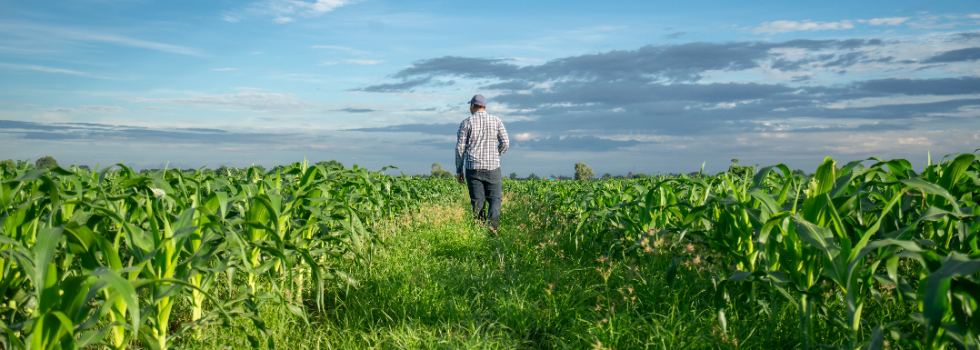Promotional Features
ADM leading in sustainability from seeds to store shelves
With a global network linking 200,000 farmers and customers, ADM is driving positive impacts in how the world uses food, fuel, consumer products and more.
ADM has an unwavering commitment to sustainability, and its position spanning the many value chains in which it operates gives it an unparalleled opportunity to contribute to the greater good while creating value for farmers, customers and consumers alike. With food production responsible for up to one-third of global greenhouse gas (GHG) emissions, ADM is harnessing its opportunity and leading the industry in adopting and advancing more responsible and sustainable practices across sectors.1 The company has committed to reducing Scope 3 emissions across its supply chain by 25% by 2035 and is working toward its aspiration of reaching net zero emissions by 2050.
Reimagining how to feed and fuel the world with the scale and speed needed has made supply chain sustainability an imperative. By meeting value chain players wherever they are – upstream, downstream or directly within business operations – ADM is unlocking new climate solutions and fostering positive change every step of the way.
Supporting farmers, supporting the land
At ADM, everything starts with the farmer. Farmers have always been stewards of the land, and ADM is partnering with them around the globe to expand regenerative agriculture programs, partnerships and initiatives that help reduce GHG emissions, improve soil health, protect water quality, sequester carbon and increase overall land and soil resiliency.
In 2022, ADM worked with farmers to enroll more than a million acres across North America in regenerative agriculture programs, resulting in an estimated reduction of 253,000 MT of CO2 and sequestration of 115,500 MT of CO2. And the company is expanding its efforts around the globe, with a target of 4 million regenerative agriculture acres by 2025.
But it takes more to make regenerative agriculture successful – it takes customers who need an increasing flow of sustainably sourced crops to meet increasing consumer demand. That’s why, last year, ADM announced a ground-breaking 7.5-year partnership with PepsiCo to support regenerative agriculture practices across shared North American supply chains. And through similar partnerships with companies like Nestle, ADM is bringing the value chain full circle, from farm to final product.
Regenerative agriculture is not the only area in which ADM is working with farmers to advance good practices that make a positive impact. About 11% of global GHG emissions are from forestry and land use change, mostly deforestation.2 That’s why ADM has made a commitment to 100% deforestation-free supply chains by 2025 for direct and indirect sourcing of all commodities around the globe.
These efforts are paying off. As of today, using ADM’s map of direct suppliers’ farms and satellite imaging, the company has measured its deforestation-free volumes in Brazil and priority regions of the Cerrado at 99%. And to further its efforts globally, ADM is partnering with stakeholders including growers, local communities, and humanitarian and environmental organizations such as Concern Worldwide and the E.O. Wilson Biodiversity Foundation to drive impact.
Decarbonizing operations and innovating new technologies
ADM has a holistic view of land, climate change and water, and the company’s own operations are a critical component of its efforts. ADM was a pioneer in carbon capture and storage, and over the last decade has safely and permanently stored more than 3.9 million metric tons of CO2 over a mile under the surface of the earth – equivalent to removing almost 870,000 gas-powered cars from the road for a year.
In Brazil, ADM has signed a 15-year agreement to purchase 31.9 megawatt hours (MWh) of energy from a wind power plant that will reduce carbon emissions by 19,000 metric tons a year. Additionally, ADM is upgrading its transportation fleet as a U.S. EPA SmartWay Certified carrier, with the implementation of fuel economy improvements and increased use of biofuels. In several U.S. facilities, ADM is undergoing conversion projects to replace coal-fired boilers with high-pressure, natural-gas-fired boilers, a project that is estimated to reduce Scope 1 and Scope 2 emissions by over 150,000 metric tons per year.
Good inputs, great partners, innovative products
More and more consumers are making it clear that they want to be able to purchase products they feel good about buying, made by companies whose values align with their own. ADM’s efforts across the value chain are meeting those needs; for example, ADM was the first major flour miller to achieve net carbon neutral status across its 22 U.S. facilities. But ADM also knows that combating climate change and fighting for a better world cannot be achieved alone.
From startups to global consumer companies, ADM is partnering with others to accelerate the solutions needed for positive global impact. Its two joint ventures with LG Chem will produce foundational ingredients for bioplastics and other plant-based products. Its partnership with Marathon Petroleum is poised to meet increasing demand for renewable diesel. Its work with innovators like Innovafeed and Spiber is powering a revolution around new sources of protein and plant-based fibers that can be used to create everything from clothes to auto parts.
Continuing ADM’s sustainability journey
There is still more work to be done, and ADM remains committed to using its capabilities for the greater good. Now, more than ever, it’s up to organizations to lead broader efforts to decarbonize and protect nature. Stay in touch on progress updates and announcements along the journey – including the upcoming COP28 conference in Dubai.
References
1. UN Enivironment Programme. Emissions Gap Report 2022: The Closing Window.
2. European Commission. Green Deal: EU agrees law to fight global deforestation and forest degradation driven by EU production and consumption.







